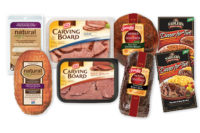Robotics have an increasingly important role in maintaining a food supply that is safe, efficient and cost-effective. To gauge the robotics industry’s importance of the food sector, the Robotic Industries Association (RIA) of Ann Arbor, Mich., sent out a survey to member companies in December 2009. RIA plans a major emphasis on the food industry in 2010, specifically making food-processing applications a priority focus. The survey serves as a base point for the focus and some of the findings are presented later within this article.
Food apps
Palletizing, packaging and packing make up the bulk of applications robotics undertake in the food sector.
“Palletizing has penetrated across all segments of the food industry, including meat, fish and poultry,” explains Rush LaSelle, director, global sales and marketing with Adept Technology Inc., Pleasanton, Calif. “Palletizing robots are at the end of the food production process, where they have made a significant impact.”
Primary packaging involves placing food items directly into its initial wrapper or package. Secondary packaging is putting those wrapped foods into a box or bag prior to palletizing. Robotics are moving upstream in the food business to primary and secondary packaging.
“Robots do a significant amount of packaging in the food industry. For many years, robots have been packaging food and putting that packaged food into cartons,” says Peter Cavallo, robot sales manager at DENSO Robotics in Long Beach, Calif.
James Cooper, vice president of sales, KUKA Robotics Corp., Clinton Township, Mich., adds that robots continue to work their way upstream in food production.
“I see a tremendous opportunity for robotics on the process side of the food industry,” he says. “While the food industry has been slow to adopt robotics for upstream processing, that area is growing.”
Cooper anticipates the most growth in food robotics over the next five years will be in primary and secondary packaging applications. Primary packaging requires a higher level of cleanliness because of the robot’s proximity to the product. The design of the robot reflects the need for sanitary operation.
“Food-grade grease is a basic requirement for most customers, says Tom Sipple, handling technology leader at Motoman Inc. of West Carrollton, Ohio. “Also, the robotics industry is offering IP67-rated washdown robots, which is the minimum that is acceptable to most meat and poultry companies.”
Why use robots?
With the economy still struggling with the recession and unemployment, why should the food industry consider investing in robotics?
“The food industry is a difficult setting for someone to work in due to health, safety and ergonomic issues,” says Richard Motley, account manager for distribution network at FANUC Robotics America Inc. in Rochester Hills, Mich. “The food industry is a tremendous opportunity for robotics.”
Because of the unavailability of labor to work in food-production plants, the need for robotics in the food industry will grow significantly.
“I see the same drivers of safety, material savings, higher productivity and yields in the food industry now as in the early days of robotic welding and painting applications,” Motley adds.
Similarly, Ted Wodoslawsky, vice president of marketing, the Robotics Division of ABB Inc. in Auburn Hills, Mich., explains that the food industry is very labor-intensive, and the work is difficult with very high turnover.
“Food production cannot be outsourced to another country, so it is a good market for robotics,” he says. Likewise, LaSelle adds, “Reports continue to show that keeping mundane tasks fully staffed remains a widespread issue in the food-processing industry, leading to high turnover rates. Given the cost to secure and train new employees, the savings robotics offers go beyond hourly wages.”
Finding and retaining labor is difficult for food manufacturers, even in uncertain economic conditions. West Liberty Foods LLC, of West Liberty, Iowa, uses robotics in its Tremonton, Utah, plant.
“We use robots to move 120-inch slicing logs to cook racks. Robotics fabricating longer logs has reduced our cost to produce them as well as enhanced food safety,” says Gerald Lessard, vice president and chief operating officer at West Liberty. He further explains that the company could note have converted its pre-sliced product from 72-inch logs to 120-inch slicing logs without robotics.
“Robotics were a simpler solution to move our logs rather than using dedicated automation, and it provides increased consistency, productivity and safety. Longer logs require less handling, and we are cognizant of safety issues, especially when it comes to repetitive motion injuries,” he adds.
Lessard contends workplace injuries are reduced using robots, and their hygienic design gives West Liberty Foods the ability to sanitize equipment with a high degree of confidence.
Clean machines
To comply with government regulations, robot makers and integrators need to design and deploy robots that can prevent build-up of bacteria and be easily sanitized. Constructing the robot from stainless steel or putting a protective suit over the robot are among strategies to meet FDA regulations.
“To maintain cleanliness standards, several robot manufacturers use stainless steel so the robot can be washed down with hot water,” says ABB’s Wodoslawsky. “Europeans cover their robots, similar to automotive painting work cells. When a robot is covered, end-users no longer have to worry about oils and grease being food-grade.”
Wodoslawsky professes that robot design is vital for a successful food application. He stresses that robot parts never made it into a consumer’s food, but the robot was redesigned to preclude that.
“We redesigned our robot so that a single piece of metal forms the top and everything is rounded so water flows off while preventing areas where contaminates can collect. The part count went down on the robot’s arm because we wanted to prevent the possibility of pieces falling into someone’s food.”
ABB also changed the paint to ensure it can withstand sustained intense water pressure.
“That is the way people behave in the actual world when washing down a robot,” says Wodoslawsky.
To help meet sanitary standards, Stäubli Corp., Robotics Division, in Duncan, S.C., offers a series of food robots.
“These specialized robots are highly resistant to these harsh chemicals and ideally suited for the food production environment,” says Sylvie Algarra, worldwide food activity specialist at Stäubli. “Tooling is also of primary concern as it’s in direct contact with food.”
Each country has different requirements for tooling around food, according to product manager Jesse Hayes of SCHUNK Inc., of Morrisville, N.C.
“International food companies need to fully understand the FDA, United States Department of Agriculture (USDA) and foreign requirements, as well as understand the materials that can be used, special contours and finish that go into tooling,” Hayes says, noting that the materials going into end-of-arm-tooling in food applications consists of more stainless steel and plastics, all of which pose unique challenges when fabricating them.
Unlike automotive parts, food items vary in size and shape from one to the next. Having a gripper that can handle them poses a challenge. Hayes cites fish patties as an example of grippers handling a delicate food with varying size and shape.
“Vacuum grippers cannot be used to pick up fish patties because the breading will clog vacuum lines,” Hayes adds. “An adjustable gripper for different shapes is used to reach underneath to remove the patties from a conveyor.”
In most robotic applications, care must be taken to protect the robot from its working environment. Heat, dust, and lubricants all need to be managed to prevent harm to the robot and peripheral equipment in the work cell. Motley points out how the tables, in a sense, must be turned when thinking about robotics in food processing.
“For years, robot manufacturers have been good at protecting the robot from severe environments,” he says. “In food applications, integrators need to protect the product and the environment from the robot.”
The Robotics Industry Association (RIA) is the only trade group in North America organized specifically to serve the robotics industry. Member companies include leading robot manufacturers, users, system integrators, component suppliers, research groups, and consulting firms. For more information about the RIA, including a complete listing of member companies contained within this article, and other supplier, integrator and consultant members, visit www.robotics.org or contact RIA Headquarters at (734) 994-6088.
Survey says ...
The Robotics Industry Association’s recent survey asked member companies to describe the current state of robotic use in North America. What follows are a few of the responses:“Robot manufactures see food processing as a growth market and are developing products that can withstand the cleaning requirements.” — John Burg, president of Ellison Technologies Automation in Council Bluffs, Iowa. Burg also says gripper design needs development to become more cost-effective and operate in a food-production environment.
“A range of applications after wrapping and prior to cartoning merit robotics and present our industry with new opportunities. I see food bags bin picking to be very promising.” — Adil Shafi, president of ADVENOVATION Inc., Houghton, Mich.
“The meat and poultry processing markets remain immature from a robotics standpoint. The food industry has been slow to adopt robots for applications other than end-of-line, so upstream processes remain an area of opportunity. Robotics have been strongly adopted in the beverage market. In addition to end-of-line applications, case-packing and carton magazine loading applications have seen implementation of robotics.” — Keith Rosnell, chief executive officer of Remtec Corp. in Cincinnati, Ohio.



Report Abusive Comment